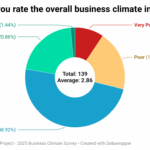Choosing Progress: A Unified Path Toward Affordability and Economic Resilience
Vermont can no longer admire the problem. It must act, guided by data, employers, and long-term planning.
Each year, the Vermont Chamber of Commerce sets legislative priorities grounded in one core objective: advancing the Vermont economy. As we enter the 2026 session, Vermont stands at a defining moment. Affordability pressures, demographic decline, and rising operating costs are converging just as our state needs more workers, more housing, and greater predictability to sustain economic growth.
Our work toward long-range strategy began with the Vermont Economic Action Plan, a statewide blueprint shaped by more than 5,000 Vermonters. The plan established a clear vision for a stronger and more affordable future, grounded in data, pairing community insight and measurable targets. It also signaled a pivotal shift in how Vermont approaches economic decision-making. Instead of reacting to problems as they arise, we now have a long-term framework that can guide policy choices and align efforts across the public and private sectors.
This alignment is urgently needed. The Vermont Futures Project’s Competitiveness Dashboard shows Vermont trailing most states in economic outlook, cost competitiveness, and regulatory efficiency. Vermont ranks 49th in Economic Outlook and continues to struggle with slow economic growth, high costs of doing business, and a demographic profile that strains employers and public systems. Results from this year’s Business Climate Survey reinforce this landscape. Employers identified taxes, regulation, labor shortages, healthcare costs, and housing challenges as the most significant barriers to growth.
Many employers voiced concern that the state’s policy direction is disconnected from Vermont’s economic reality, and that they do not feel heard in Montpelier. Business leaders shared examples of policy decisions advancing without a clear understanding of operational impacts. This sentiment reflects a growing disconnect at the same moment Vermont needs alignment around affordability, stability, and long-term economic strategy. It also underscores the essential role the Vermont Chamber plays in bringing employer perspectives to the policy and regulatory tables and ensuring economic policy aligns with economic reality. Addressing Vermont’s challenges requires a sustained commitment to coordinated, data-informed action.
Many employers voiced concern that the state’s policy direction is disconnected from Vermont’s economic reality, and that they do not feel heard in Montpelier. Business leaders shared examples of policy decisions advancing without a clear understanding of operational impacts. This sentiment reflects a growing disconnect at the same moment Vermont needs alignment around affordability, stability, and long-term economic strategy. It also underscores the essential role the Vermont Chamber plays in bringing employer perspectives to the policy and regulatory tables and ensuring economic policy aligns with economic reality. Addressing Vermont’s challenges requires a sustained commitment to coordinated, data-informed action.
How confident or concerned are you about Vermont’s elected officials understanding of the economic pressures facing businesses?
A post on Datawrapper provided by: https://datawrapper.de
While there is difficult work ahead, progress was made last year on housing infrastructure, workforce programming, and slowing the growth of healthcare costs. While these advances were important, they are not enough on their own. Vermont must shift from episodic decision-making to a consistent, long-range economic strategy. The Economic Action Plan provides that roadmap. Paired with disciplined and transparent leadership, it offers a path toward measurable improvements for both families and employers.
Our 2026 legislative agenda reflects this approach and focuses on four core areas aligned with statewide priorities and employer needs:
Economic Abundance Through Fiscal Stewardship
Vermont must adopt predictable fiscal practices that control cost growth and strengthen affordability for families and employers. With state spending up more than three billion dollars in five years, the need for disciplined decision making is clear.
Regulatory Modernization and Predictability
A modernized regulatory system must support timely housing and economic development. Streamlined permitting and clearer rules will reduce costs, shorten timelines, and restore Vermont’s competitiveness.
Workforce and Housing Alignment
Employers report that workforce pressures and housing shortages remain among their highest concerns. Strengthening recruitment and retention requires connecting training strategies, talent attraction, and coordinated housing solutions.
Industry Competitiveness
Manufacturing, tourism, healthcare, technology, and small businesses all face rising pressures. Strategic investments in infrastructure, innovation, and cost containment will strengthen these key sectors.
As we begin the 2026 session, Vermont faces a choice. We need to shift from a scarcity mindset to an abundance mindset. The path forward requires courage, collaboration, and a commitment to measurable progress. Employers are ready to be partners in this work. Policymakers must be equally ready to align decisions with long-term strategy and economic reality.
Vermont’s future is not predetermined. It is shaped by the choices we make together. The Vermont Chamber stands ready to partner in this work and ensure our state’s economic story continues toward resilience, prosperity, and opportunity for all.




